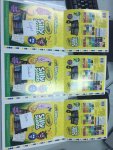thaiha
Member
Dear all,
I'm new member. I need advice from all of you the way to making standard book with Light - Standard - Dark.
The current method I'm doing is using tolerance of density reference with GRACoL page 21, Section 6.2 - Calibrating, Printing and Proofing
Cyan 1.45+/-0.1
Magenta 1.45+/-0.1
Yellow 1.0+/-0.07
Black 1.7+0.2-0.05
I will making the standark tone first, then record density of all inks.
Second reduce (-0.1) density of all ink compare with standard --> light tone
Finally increase (+0.1) density of all ink compare with standard --> dark tone
So, I need get advice from all of you, If you have any method to do better.
Thanks all
Thaiha
I'm new member. I need advice from all of you the way to making standard book with Light - Standard - Dark.
The current method I'm doing is using tolerance of density reference with GRACoL page 21, Section 6.2 - Calibrating, Printing and Proofing
Cyan 1.45+/-0.1
Magenta 1.45+/-0.1
Yellow 1.0+/-0.07
Black 1.7+0.2-0.05
I will making the standark tone first, then record density of all inks.
Second reduce (-0.1) density of all ink compare with standard --> light tone
Finally increase (+0.1) density of all ink compare with standard --> dark tone
So, I need get advice from all of you, If you have any method to do better.
Thanks all
Thaiha















